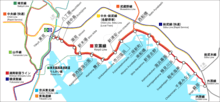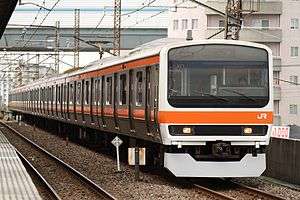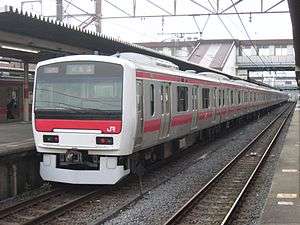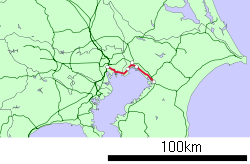Keiyō Line
The Keiyō Line (京葉線, Keiyō-sen) is a railway line connecting Tokyo and Chiba in Japan, paralleling the edge of Tokyo Bay. It is operated by the East Japan Railway Company (JR East). The line forms part of what JR East refers to as the "Tokyo Mega Loop" (東京メガループ) around Tokyo, consisting of the Keiyo Line, Musashino Line, Nambu Line, and Yokohama Line.[2] It provides the main rail access to the Tokyo Disney Resort and the Makuhari Messe exhibition center. The terminus at Tokyo Station is located underground, some distance to the south of the main station complex approximately halfway to Yūrakuchō Station. This means transfer between other lines at Tokyo Station can take between 15 and 20 minutes. The name "Keiyō" is derived from the second characters of the names of the locations linked by the line, Tokyo (東京) and Chiba (千葉). It should not be confused with the Keiō Line, a privately operated commuter line in western Tokyo.
| Keiyō Line | |||
|---|---|---|---|
| JE | |||
A Keiyō Line E233-5000 series EMU in July 2010 | |||
| Overview | |||
| Native name | 京葉線 | ||
| Type | Commuter rail | ||
| Status | Operational | ||
| Locale | Tokyo, Chiba Prefecture | ||
| Termini | Tokyo Soga | ||
| Stations | 18 | ||
| Daily ridership | 714,053 (Daily 2015)[1] | ||
| Operation | |||
| Opened | 1975 | ||
| Owner | JR East | ||
| Character | Underground, at-grade, elevated | ||
| Depot(s) | Narashino | ||
| Rolling stock | E233-5000 series, 209-500 series | ||
| Technical | |||
| Line length | 43 km (27 mi) | ||
| Track gauge | 1,067 mm (3 ft 6 in) | ||
| Electrification | 1,500 V DC overhead catenary | ||
| Operating speed | 100 km/h (60 mph) | ||
| |||
Services

- Keiyō Line "Local" (各駅停車 kakueki-teisha)trains stop at all stations between Tokyo and Soga except Nishi-Funabashi.
- Musashino Line ''Local'' through trains stop at all stations between Tokyo and Nishi-Funabashi before continuing to the Musashino Line. Some trains stop at Nishi-Funabashi, Minami-Funabashi, Shin-Narashino, and Kaihimmakuhari.
- Keiyō Line "Rapid" (快速 kaisoku) trains stop at Tokyo, Hatchōbori, Shin-Kiba, Maihama, Shin-Urayasu, Minami-Funabashi, Kaihimmakuhari, and all stops to Soga.
- Commuter rapid service (通勤快速, tsūkin-kaisoku) trains stop at Tokyo, Hatchōbori, Shin-Kiba, and Soga.
Station list
- All trains (except limited express services) stop at stations marked "●" and pass those marked "|". Trains do not travel past those stations marked "∥".
- For the Wakashio and Sazanami limited express services, see their respective articles.
| No. | Station | Japanese | Distance (km) | Keiyō Line |
Musashino Line (thru) |
Transfers | Location | |||||
|---|---|---|---|---|---|---|---|---|---|---|---|---|
| Between stations |
Total | Local | Rapid | Comm. Rapid |
Musashino-Chiba | Musashino-Tokyo | ||||||
TYOJE01 |
Tokyo | 東京 | - | 0.0 | ● | ● | ● | ● |
|
Chiyoda | Tokyo | |
| JE02 | Hatchōbori | 八丁堀 | 1.2 | 1.2 | ● | ● | ● | ● | H Tokyo Metro Hibiya Line (H-12) | Chūō | ||
| JE03 | Etchūjima | 越中島 | 1.6 | 2.8 | ● | | | | | ● | Kōtō | |||
| JE04 | Shiomi | 潮見 | 2.6 | 5.4 | ● | | | | | ● | ||||
| JE05 | Shin-Kiba | 新木場 | 2.0 | 7.4 | ● | ● | ● | ● |
| |||
| JE06 | Kasai-Rinkai Park | 葛西臨海公園 | 3.2 | 10.6 | ● | | | | | ● | Edogawa | |||
| JE07 | Maihama | 舞浜 | 2.1 | 12.7 | ● | ● | | | ● | Disney Resort Line (Resort Gateway) | Urayasu | Chiba | |
| JE08 | Shin-Urayasu | 新浦安 | 3.4 | 16.1 | ● | ● | | | ● | ||||
| JE09 | Ichikawashiohama | 市川塩浜 | 2.1 | 18.2 | ● | | | | | ● | Ichikawa | |||
| JM10 | Nishi-Funabashi | 西船橋 | 5.9 | 24.1 | ∥ [* 1] |
∥ | ∥ | ● | ● |
|
Funabashi | |
| JE10 | Futamatashimmachi | 二俣新町 | 4.4 | 22.6 | ● | | | | | ∥ [* 2] |
Distance is from Ichikawashiohama | Ichikawa | ||
| JE11 | Minami-Funabashi | 南船橋 | 3.4 | 26.0 | ● | ● | | | ● | Distance between Nishi-Funabashi and Minami-Funabashi is 5.4 km | Funabashi | ||
| JE12 | Shin-Narashino | 新習志野 | 2.3 | 28.3 | ● | | | | | ● | Narashino | |||
| JE13 | Kaihimmakuhari | 海浜幕張 | 3.4 | 31.7 | ● | ● | | | ● | Mihama-ku | |||
| JE14 | Kemigawahama | 検見川浜 | 2.0 | 33.7 | ● | ● | | | |||||
| JE15 | Inagekaigan | 稲毛海岸 | 1.6 | 35.3 | ● | ● | | | |||||
| JE16 | Chibaminato | 千葉みなと | 3.7 | 39.0 | ● | ● | | | Chiba Urban Monorail: Line 1 | Chūō-ku, Chiba | |||
| Soga | 蘇我 | 4.0 | 43.0 | ● | ● | ● |
| |||||
- Keiyō trains between Tokyo and Soga do not pass through Nishi-Funabashi.
- Musashino Line trains do not pass through Futamatashimmachi.
- Some local and rapid, and all Commuter Rapid trains, run through to the Uchibō Line (mainly to Kimitsu or Kazusa-Minato) or the Sotobō Line (mainly Kazusa-Ichinomiya, Katsuura, and via the Tōgane Line to Narutō).
New station development plan
There is a new station construction plan between Shin-Narashino Station and Kaihimmakuhari Station.[3]
Rolling stock
All Keiyō Line and Musashino Line rolling stock is based at the Keiyō Rolling Stock Center near Shin-Narashino Station.
Keiyō Line
- 209-500 series 10-car EMUs (magenta stripe) (since October 2008)
- E233-5000 series 10-car EMUs (magenta stripe) (since 1 July 2010)[4]
Musashino Line through services
- 205-5000 series 8-car EMUs (orange/brown stripe) (since 2002)
- 209-500 series 8-car EMUs (orange/brown stripe) (since 4 December 2010)[5]
- E231-0 series 8-car EMUs (orange/brown stripe) (since November 2017)
- E231-900 series 8-car EMU (orange/brown stripe) (since 20 July 2020)[6]
- A Keiyo Line 209-500 series 10-car EMU
 A Keiyo Line E233-5000 series EMU
A Keiyo Line E233-5000 series EMU- A Musashino Line 205-5000 series EMU
 A Musashino Line 209-500 series 8-car EMU
A Musashino Line 209-500 series 8-car EMU A Musashino Line E231 series 8-car EMU
A Musashino Line E231 series 8-car EMU
Rolling stock used in the past
Keiyō Line
- 103 series 4/6/10-car EMUs (sky blue livery) (from 1986 until November 2005)
- 165 series 3-car EMU (x1) Shuttle Maihama (from 1990 until 1995)
- 201 series 10-car EMUs (sky blue livery) (from August 2000 until 20 June 2011)[7]
- 205-0 series 10-car EMUs (magenta stripe) (from March 1990 until 2011)
- E331 series 14-car EMU (x1) (magenta stripe) (from March 2007 until 2011)[8]
Musashino Line through services
Inter-running from the Musashino Line to the Keiyō Line commenced on 1 December 1988.[9]
- 103 series 6-car (later 8-car) EMUs (orange livery) (from 1 December 1988 - 8 December 2005)
- 201 series 6-car EMUs (orange livery) (from 1 December 1988 - 1990)
- 205-0 series 8-car EMUs (orange/brown stripe) (from December 1991 - October 2019)
 A Keiyo Line 103 series EMU
A Keiyo Line 103 series EMU A 165 series Shuttle Maihama EMU set, March 1990
A 165 series Shuttle Maihama EMU set, March 1990- A Keiyo Line 201 series EMU, July 2010
 A Keiyo Line 205 series EMU, May 2008
A Keiyo Line 205 series EMU, May 2008 The Keiyo Line E331 series EMU, May 2010
The Keiyo Line E331 series EMU, May 2010 A Musashino Line 103 series EMU, August 2001
A Musashino Line 103 series EMU, August 2001 A Musashino Line 205-0 series EMU
A Musashino Line 205-0 series EMU
History
The Keiyo Line was initially planned as a freight-only line. Its first section opened on 10 May 1975 as a 6.5 km link between the Chiba Freight Terminal (now the Mihama New Port Resort between Inagekaigan and Chibaminato Stations) and the freight yard next to Soga Station.[10] Passenger service began on 3 March 1986 between Minami-Funabashi and Chibaminato, and was extended eastward to Soga and westward to Shin-Kiba on 1 December 1988.[10]
The final section of the Keiyo Line between Tokyo and Shin-Kiba opened on 10 March 1990.[10] The platforms at Tokyo Station were originally built to accommodate the Narita Shinkansen, a planned (but never built) high-speed rail line between central Tokyo and Narita International Airport.[11]
Planners originally envisioned the Keiyo Line interfacing with the Rinkai Line at Shin-Kiba, thus providing a through rail connection between Chiba and the Tokyo Freight Terminal in eastern Shinagawa, and also completing the outer loop for freight trains around Tokyo formed by the Musashino Line. This original plan would also allow through service with the Tokaido Main Line, allowing freight trains from central and western Japan to reach Chiba and points east.
However, in the 1990s, as the artificial island of Odaiba began developing as a commercial and tourist area in the middle of the Rinkai Line route, the Rinkai Line was re-purposed for use as a passenger line. While there is a through connection between the Rinkai Line and the Keiyo Line, it is only used by passenger trains in charter service, usually carrying groups to the Tokyo Disney Resort.
Timeline
- 3 March 1986: First stage opened between Minami-Funabashi and Chibaminato.[12]
- 1 December 1988: Second stage opened between Shin-Kiba and Minami-Funabashi, and between Ichikawashiohama and Nishi-Funabashi.[12]
- 10 March 1990: Third stage opened between Tokyo & Shin-Kiba;[12] and the new Keiyo Line train, the 205 series, was also introduced to the public.
- 16 March 1991: Sazanami and Wakashio limited express services are rerouted via the Keiyo Line.[12]
- 2 July 1993: 255 series EMUs are introduced on View Sazanami and View Wakashio limited express services.[12]
- 16 October 2004: E257-500 series EMUs are introduced on Sazanami and Wakashio limited express services.[12]
References
- "平成27年 大都市交通センサス 首都圈報告書" (PDF). P.92. 国土交通省.
- Saka, Masayuki (August 2014). 東京メガループ 車両・路線の沿革と現況 [Tokyo Megaloop: History and current situation of trains and line]. Tetsudō Daiya Jōhō Magazine (in Japanese). Vol. 43 no. 364. Japan: Kōtsū Shimbun. pp. 28–39.
- 幕張新都心拡大地区新駅設置に係る基本調査結果の概要について (in Japanese). Japan: Chiba Prefectural Government. Retrieved 4 February 2017.
- "E233系5000番代 営業運転開始 (E233-5000 series enters revenue service)". Hobidas (in Japanese). Neko Publishing. 1 July 2010. Retrieved 24 March 2014.
- JR電車編成表 2013夏 [JR EMU Formations - Summer 2013]. Japan: JRR. May 2013. p. 47. ISBN 978-4-330-37313-3.
- "【元209系】E231系900番台試作車・MU1編成として武蔵野線で"再出発"" [[Former 209 series] E231-900 series prototype train restarts on Musashino Line as MU1]. 20 July 2020.
- 京葉線の201系が定期運用を終える [Keiyō Line 201 series withdrawn from regular service]. Japan Railfan Magazine Online (in Japanese). Japan: Koyusha Co., Ltd. 21 June 2011. Retrieved 21 June 2011.
- "E331系AK1編成長野へ配給" [E331 series set AK1 moved to Nagano]. RM News (in Japanese). Japan: Neko Publishing Co., Ltd. 27 March 2014. Archived from the original on 27 March 2014. Retrieved 10 April 2014.
- 首都圏鉄道完全ガイド 主要JR路線編 [Tokyo Area Complete Railway Guide - Major JR Lines]. Japan: Futabasha. 6 December 2013. pp. 87–97. ISBN 978-4-575-45414-7.
- Ishino, Tetsu, ed. (1998). 停車場変遷大辞典 国鉄・JR編 [Station Transition Directory - JNR/JR]. I. Japan: JTB. p. 211. ISBN 4-533-02980-9.
- "東京駅の京葉線、なぜ遠い?近道は有楽町 成田新幹線構想を再利用" [Why is Keiyo Line so far away at Tokyo Station?]. Nikkei Shimbun. 4 February 2014. Retrieved 4 February 2014. (registration required)
- Kubo, Satoshi (August 2015). 東京駅開業100周年-5 京葉線ターミナル [Tokyo Station 100th Anniversary (5) Keiyo Line Terminal]. Japan Railfan Magazine (in Japanese). Vol. 55 no. 652. Japan: Koyusha Co., Ltd. p. 105.
External links
| Wikimedia Commons has media related to Keiyō Line. |
- Stations of the Keiyō Line (JR East) (in Japanese)

.svg.png)